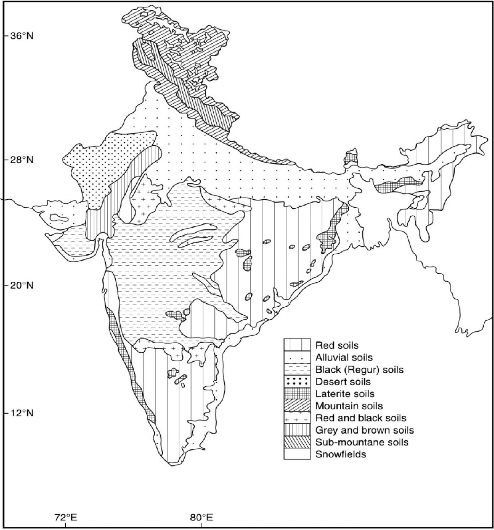CLASSIFICATION OF SOILS OF INDIA
A number of attempts have been made to classify the soils of India during the last century. The first scientific classification oflndian soils was made by Voelekcr (1893) and Leather (1898). According to them the Indian soils may be classified into four categories, namely (i) alluvial, (ii) regur (black earth), (iii) red soil, and (iv) lateritic soil.
Subsequently, on the basis of texture, structure, colour, pH value and porosity, the All India Soil and Land Use Survey Organisation attempted a classification of soils of India in 1956. In 1957, the National Atlas and Thematic Mapping Organisation published a soil map of India in which Indian soils were classified into six major groups and eleven sub-groups. In 1963, the Indian Council of Agricultural Research, under the supervision of S.P. Ray Chaudhry, published a soil map of India in which the soils have been divided into seven groups. More recently, the Indian Council of Agricultural Research, on the basis of texture, structure, colour, pH value, and porosity has identified the following types of soil groups. [Table 6.1 (Fig. 6.3)].
1. Alluvial soils
2. Red soils
3. Regur (Black-earth) soils
4. Desert soils
5. Laterite soils
6. Mountain soils
7. Red and Black soils
8. Grey and Brown soils
9. Submontane soils
10. Snowfields.

Fig. 6.3 Soils
Table 6.1 Types of Soils, their Area and Percentage to Total Reporting Area
Soil types | Area in million hectares | Percentage |
1. Alluvial soil | 143.1 | 43.36 |
2. Red soil | 61.0 | 18.49 |
3. Black (Regur) soil | 49.8 | 15.09 |
4. Mountain soil | 18.2 | 5.51 |
5. Red and Black soil | 17.8 | 5.40 |
6. Desert soil | 14.6 | 4.42 |
7. Laterite soil | 12.2 | 3.70 |
8. Grey and Brown soil | 3.6 | 1.09 |
9. Submontane-soil | 5.7 | 1.73 |
10. Snowfields | 4.0 | 1.21 |
11. Other soils | ||
12. Total reported area | 330.0 | 100.00 |
